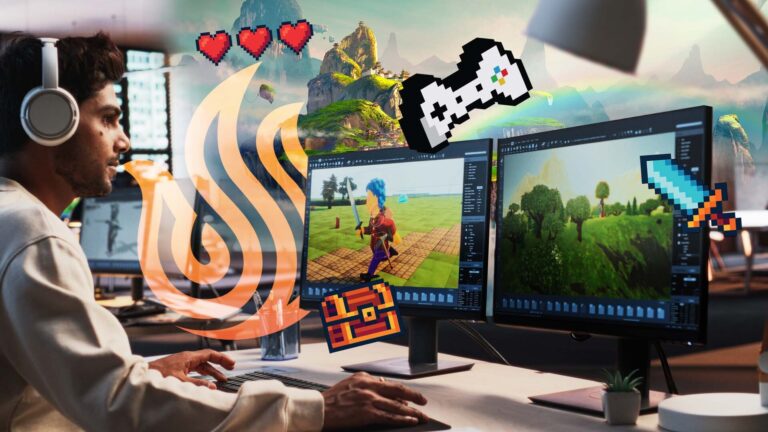Video game design is an excellent profession for creative people who love video games. Not only do you get to work on the art pieces you love, but your mind remains stimulated with interesting challenges. This prevents the profession from growing stale or boring. There is always more to learn in the field of game design and engineering.
Of course, the fun nature of this career path might make some people skeptical at first. The most respectable professions often fall under the STEM designation. Luckily, video game design and engineering fit snugly into several branches of the STEM paradigm. As you learn more about what this entails, you will be able to explain the career to your friends and family in a manner that commands respect.
What is STEM?
STEM is an acronym for Science, Technology, Engineering, and Math. Together, these four pillars make up the core of modern education curriculums. By incorporating each of these four disciplines, students develop 21st century skills that prepare them for the future. Since the world now runs on computers and the vast amounts of data they process, an understanding of STEM principles has become just as crucial as the ability to read and write.
Science
Science is the process of observing the world and analyzing it through empirical data. The goal of scientists is to discover how the world works and use these basic laws to further human knowledge. When you first think of this field, you may think of topics such as Biology, Chemistry, and Physics. While these subjects can help you to work on your game worlds, they are not part of your core training as a game designer. However, the topic of computer science perfectly encapsulates game development principles.
Computer science takes the fundamental goals of the field and applies them to digital technologies. By understanding how computers function, you can create an effect similar to what traditional scientists make in the real world. You will obtain a firm grasp on computer science as you explore both the hardware and software used to design games. Coding, networking, and managing software all fall under the computer science umbrella. As these are all things you will learn during a game engineering degree program, you can rest assured the courses fall under the STEM banner.
Technology
Technology is the process of creating usable items that assist people in completing tasks more efficiently. Advanced tech can also introduce new possibilities into the human condition. Technological advances started with simple tools such as sticks and wheels in ancient history. Nowadays, most technology involves electrical components. That includes video games, computers, controllers, and other gaming accessories.
Your game engineering degree program easily fits the technology portion of STEM. You gain a mastery of computer technology in addition to familiarity with most other electronic devices. Then, there are the ambitious game designers pushing the boundaries of programming. Namely, virtual reality and augmented reality devices are paving the way for a new generation of digital entertainment. Exploring this new frontier is more than worthy of STEM designation.
Engineering
Engineering involves the use of science and mathematics to create objects and systems that are reliable. Engineers craft much more than engines and other vehicle parts. Buildings, bridges, new inventions, roads, and power plants must all be carefully constructed through engineering principles. While engineering typically applies to physical reality, the same principles can apply to the digital worlds created by game designers.
When learning how to create digital game worlds, you will need to apply the same knowledge engineers use to make real objects. Your game will likely emulate physics in a fairly realistic manner. Even if you prefer a more exaggerated physics system for your title, the same methods are used to establish each interaction. Your digital bridge must stay upright as your player walks across it. Likewise, your bridge must fall in a believable manner when hit with an explosive blast. You will learn a great deal of engineering as you study game development, so your degree fully falls under this category of the STEM umbrella.
Math
Math is the use of numbers and shapes to measure and understand the universe. Everything in reality can be broken down into simple mathematic concepts. Then, each concept is combined to create the complex world we find ourselves in. Studying Math gives you a greater understanding of how everything in the universe works. As you can imagine, this is incredibly useful to anyone designing a digital world brimming with detail.
Your game design degree will include Math curriculum. This is important for determining things like the arc of a grenade traveling through the air or where your bullets will land after you shoot a weapon. Most game maps are created on a grid so that each object in the scene can be spaced out correctly. An astute awareness of Math will make plotting out your levels that much easier. Due to all of the Math needed to make games, your degree will easily qualify for this portion of the STEM designation.
Is Game Design a STEM Degree?
Game design is an excellent example of a STEM degree. You will learn a great deal of computer science as well as physics when working on your game projects for each class. Both subjects fall under the science portion of the STEM umbrella. You will need these core skills to create enjoyable game experiences.
As for technology, you will be immersed in top-of-the-line hardware and software. You will learn far more than the average IT student would during their curriculum. In addition to masterful knowledge of traditional computing, game designers are on the forefront of advanced tech such as virtual reality. With the buzz surrounding VR games and metaverses, the tech background you establish through games will open many doors for you in the future.
To make each scene as believable as possible, a firm grasp on engineering is required. Buildings and other structures often look a certain way out of necessity. By learning the engineering principles that explain how objects are constructed, you can recreate them in a digital environment. Demonstrating this ability is worthy of a STEM accreditation.
Last, but not least, Mathematics is a crucial component of making games. Not only are game worlds developed on a grid, but Math can be used to accurately portray each motion and interaction within the digital world. You can use Math to determine distance, plot how an object moves through the air, and everything else that drives gameplay forward. Since you will study quite a bit of Math during your degree, it absolutely constitutes a STEM career path.
How Do You Become a Game Designer?
By far the most succinct way to become a game designer is to attend a formal education program. The road ahead is still challenging, though you have the best backup possible when engaged in a curated curriculum. You will be instructed by industry professionals with their name in the credits of published titles. They will help guide you through the initial steps of understanding the hardware, software, and game development process.
Learning everything on your own can be extremely overwhelming. What’s even worse is the varying quality of online tutorials and references. The information contained online may be outdated or completely incorrect. When enrolled in a degree program, you can rest assured you are learning relevant facts that will help further your career.
What Do You Learn During a Game Engineering Degree Program?
Your degree program will prepare you for game development by walking you through each step of the process. Gaining familiarity in each area will simplify the job search when you graduate. Before working on digital projects, you first learn about traditional art principles. Studying what makes a design appealing will help you create the best digital worlds possible when sitting at the computer.
Next, you will explore the game design process through various team projects. The best way to learn how to make games is to start making them. In addition to the core game design skills necessary to build digital worlds, you will also learn how to collaborate with teammates. Since modern games staff hundreds of people, learning clear and efficient communication is mandatory.
Each team project involves building a game prototype. Each prototype will focus on the specifics of game design with only a slight bit of artistry included. You will learn how to add textures to game objects, but the main focus will be on the layout of said objects through the lens of level design. You will learn how to engage players in a variety of ways. From short stints of action to adventures that last dozens of hours, you will explore how to pace and balance a game for optimal enjoyment. Despite all the creativity involved, there are many objective reasons why games are satisfying. Learning each one will catapult your designs to a professional level of quality.
Other game elements such as storytelling, immersion, sound design, usability, and monetization are also covered. Modern audiences demand more than simply a fun gameplay loop. Your team must develop a fully realized digital world with impressive production value in all technical aspects. A complete package has a much greater chance of success on the market.
Of all these elements, usability is arguably the most important. The most popular games in recent memory are all easy to pick up and play. Titles such as Call of Duty, Minecraft, and Among us exploded in popularity due to the simplicity of getting started and instantly understanding how the game works. Controls and graphical interface are the two key factors in this. The degree program will cover both in extensive detail over the course of multiple classes. You will learn how to refine game feel to make movement satisfying and discover how to create menu/inventory screens that are easy to understand. A combination of smooth controls and intuitive menus will make your games far more palatable to a general audience.
Want to Learn More?
Now that you know that game design is a STEM degree, take the time to learn more about the University of Silicon Valley? As the video game industry continuously grows, employers are zeroed in on Game Art and Game Engineering students who understand both the creative and technical sides of the industry. Nowhere is University of Silicon Valley’s unique ability to combine specializations better demonstrated than in our school’s Game Design & Development Department
University of Silicon Valley is uniquely poised to offer a meaningful and valuable education for 21st century students. We believe in an education that directly correlates with the work you’ll be doing after you graduate. Interested in learning more? Contact Us today.


